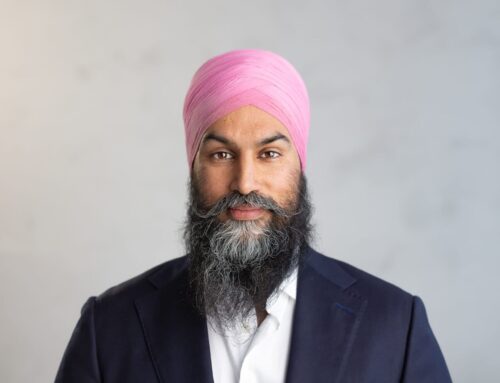With Liza Vityuk at McKinsey & Company. Discrimination based on gender and other connected factors like our race and ability impacts our health in so many ways. In honour of International Day of Action for Women’s Health, we’ve focused on gender and health matters we may know bits and pieces of but probably need to learn more about.
Our guest Liza Vityuk is Partner at McKinsey & Company. She has more than 15 years of experience in commercial and growth strategies, building digital businesses, and improving customer experience globally. Liza is the Chair of the Diversity, Equity, and Inclusion Committee in Canada, overseeing efforts for more than 1,300 colleagues. She joins us to speak to McKinsey Health Institute’s 2024 report, “Closing the women’s health gap: A $1 trillion opportunity to improve lives and economies”. It points to some big findings.
- While women live longer than men, they spend 25% more of their lives in debilitating health.
- The study of biology defaults to the male body, which results in many treatments being less effective for women.
- Women face more barriers to care, timely diagnosis, and good healthcare treatment.
- And health burdens for women are systematically underestimated, with datasets that exclude or undervalue important conditions.
This is our last episode of Alright, Now What? for few months. We’re taking a summer break and will start up again in the fall with more great topics and guests. Thank you so much for your listenership and support.
Transcript
00:00:07 Liza
First, that women live longer, therefore they must be healthier. That’s not true. In Canada, women spend 20% more time in poor health compared to men.
00:00:19 Andrea
What’s the big data story on the gender gap in health and what can we do to close it?
I’m Andrea Gunraj from the Canadian Women’s Foundation.
Welcome to Alright, Now What? a podcast from the Canadian Women’s Foundation. We put an intersectional feminist lens on stories that make you wonder, “Why is this still happening?” We explore systemic routes and strategies for change that will move us closer to the goal of gender justice.
The work of the Canadian Women’s Foundation and our partners takes place on traditional First Nations, Métis, and Inuit territories. We are grateful for the opportunity to meet and work on this land, however, we recognize that land acknowledgements are not enough. We need to pursue truth, reconciliation, decolonization, and allyship in an ongoing effort to make right with all our relations.
00:01:13 Andrea
The link between experiences of discrimination and your health and wellness is undeniable. It’s all about the “social determinants of health.”
Discrimination based on gender and other connected factors, like our race and ability, impacts our health in so many ways. For example, we get treated differently based on our gender in healthcare settings. Our access to relevant health services and options differs wildly depending on our gender. Even the medical research that gets funded and acted on depends on our gender.
In honour of International Day of Action for Women’s Health, we’ve focused on gender and health matters we may know bits and pieces of but probably need to learn more about.
Our guest Liza Vityuk is Partner at McKinsey & Company. She has more than 15 years of experience in commercial and growth strategies, building digital businesses, and improving customer experience globally. Liza is the Chair of the Diversity, Equity, and Inclusion Committee in Canada, overseeing efforts for more than 1,300 colleagues.
She joins us to speak to McKinsey Health Institute’s 2024 report, “Closing the women’s health gap: A $1 trillion opportunity to improve lives and economies.” The report points to some big findings.
- While women live longer than men, they spend 25% more of their lives in debilitating health.
- The study of biology defaults to the male body, which results in many treatments being less effective for women.
- Women face more barriers to care, timely diagnosis, and good healthcare treatment.
- And health burdens for women are systematically underestimated, with datasets that exclude or undervalue important conditions.
This is our last episode of Alright, Now What? for a few months. We’re taking a summer break and will start again in the fall with more great topics and guests.
00:03:04 Liza
I’m Liza Vityuk, I’m a Partner with McKinsey & Company here in Toronto, and I’ve been serving consumer clients globally on growth, digital business building, especially in women’s health space. I also chair our Diversity, Equity, and Inclusion Committee here in Canada for our four offices. And even though I’ve been working on women’s health for a long time, there is always something new that I learn.
I personally am a newcomer to Canada. I moved to Toronto just shortly pre-COVID and this afforded me an opportunity to navigate Canadian healthcare personally and professionally. And I found myself pregnant for the first time in a pre-vaccine pandemic with no family doctor, no friends, no family anywhere nearby. And I also had a severe chronic lung condition.
My story ends—has a very happy ending. I’m a very proud mom of a busy toddler. But even with all the resources that I had on my hands, there were many moments where I was feeling invisible, vulnerable, lost, and, like, anxious.
And from this experience, I reaffirmed my passion to advocate for women’s health and leverage my knowledge and my voice to bring the solution together and bring stakeholders on board.
00:04:26 Andrea
Overall, what is the data telling us about the health gap for women?
00:04:30 Liza
In the recent research, we—as McKinsey published together with World Economic Forum—we analyzed conditions that represent around 90% of different women’s diseases, and we looked into hundreds of interventions. The facts that we collected really uncovered the complementing story to what we are hearing and experiencing as women. And if you are one of those stories, you are not alone.
And a few myths that we dispelled along the way: first, that women live longer, therefore they must be healthier. That’s not true. In Canada, women spend 20% more time in poor health compared to men. And it’s not just reproductive health. Women-specific conditions are just 5%—a mere 5%—of this gap. And it’s not that only women in older age are affected. It’s actually starting very young and affects throughout our lives.
But living beyond the numbers, [there are] few examples that ring especially true for many Canadian women, like endometriosis. Imagine a girl who’s been excelling at school and suddenly starts experiencing pain, cramps, bleeding, misses classes, opts out of her sports, closes down to her friends—and on average, it will take 10 years to diagnose endometriosis and maybe a dozen of doctor visits. And this condition affects about 10% of women.
It can happen also with conditions that affect both men and women, like, let’s take heart attacks. Women are seven times more likely to get discharged or misdiagnosed when they’re having a heart attack, and one of the reasons is that the textbook symptoms were described on men—which is chest thumping—and they do not always apply to women at the same proportion. Women are often experiencing migraines or more intermittent type of pain. And our healthcare is built on a simple assumption that there are very few sex differences between men and women beyond the reproductive health—and this is not true.
Women are not small men. Just under half of the interventions have sex segregated data. And when they do show sex segregated data, in 64% [of] times, women are disadvantaged in treatment.
In simple terms for our fellow Canadian women, it means that when we are prescribed treatments for asthma or stroke, we are likely getting something that is much less effective than on a fellow man, just because it was not studied. And all this amounts to years living in disability that take away from being with our families, pursuing our careers, being in our communities, and just, like, enjoying life.
Closing [the] women’s gap is not just a moral imperative—it is also an economic one. There is a real business case for significant investment in advancing women’s health. Globally, there is a $1 trillion gap in GDP that is a result of health inequity. And this is a conservative estimate based on the data that is collected and not just omitted. In Canada, we’re talking about a $27 billion gap in GDP. And the majority of this disease burden comes during the working age and, like menopause, it affects in our prime lifetime and prime career time.
The good news I have is that it’s a very wise investment; for every dollar that we can spend and invest in this, it will bring $3 of pay back.
00:08:08 Andrea
How does the health gap show up differently in the lives of different women and gender-diverse people?
00:08:13 Liza
Thank you for this question. The term “women” that we use throughout the report mostly applies to cisgender women and female biology in general. We acknowledge the importance of getting more data and research around the challenges that transgender, gender fluid, or nonbinary communities face, and having data on the female body is just the first step.
And we know that barriers to health is just one of the many barriers that those communities face. And we have, in another report published by McKinsey on inclusivity that we examine the impact of race, gender, sexuality, and how it shapes the experiences of Canadians, we found that many marginalized communities across Canada—they report significant gaps in access to healthcare, much higher health debt and housing insecurity. And those insufficiencies are really multiplied when you look at it cross-sectionally.
We start with women, but this is really a broader challenge ahead of us.
00:09:20 Andrea
What do we need to do to close the health gap and health data gap in Canada?
00:09:25 Liza
One thing that’s very clear, it has to be a comprehensive ecosystem approach—public and private, working together to close this gap—and it begins exactly as you said, with the proper data collection. Acknowledging women are not small men and dedicating research to documenting biology symptoms and additional risk factors.
Investment is another important component, and if we take endometriosis, it affects one in ten women and there are only 20 treatments in the pipeline right now, with some very exciting progress made over the past few weeks. But if we compare it to diabetes, which has a similar one to ten prevalence in adults, we see 580 potential treatments that are in the pipeline.
And consider just how much money is not going to women-specific research. It is just 6% in Canada and UK that that has this designation for the grants. And if I can unpack it on one example to make it a bit more concrete on how the constellation of players can come together and help solve the challenge.
So, if we go back to the endometriosis case, and imagine it starts with investment and research that triggers life science players to develop more effective treatments, combined with training of the doctors and expanding definition of sex-appropriate care that insurers have—and improving access for all women, and consumer product companies also coming up with effective symptom management and lifestyle solutions, and we’re mandated to have better tracking and better reporting—which in turn leads to much more data and insights generated and kind of creates this positive circle of really solving the problem. And for that girl, it would mean that she doesn’t have to put her dreams on hold for ten years.
00:11:19 Andrea
Can you offer any tips or advice for listeners who want to be a part of the solution but don’t know where to start?
00:11:24 Liza
For me, it’s awareness, awareness, awareness. Advocacy and normalizing this discussion in the broad light of day is our very first step, and I can offer three tangible tips that I personally take on.
One, listen to your intuition, seek help, advocate for yourself. Get this thing that bothered you a bit checked. And, you know, you always know best.
Second, create space in your communities to talk about those health challenges. I’m amazed how little we share and how magical the unlocks become when we are open and can encourage each other to take good care of ourselves, and even just share information on, like, symptoms and different approaches.
And finally, we’re all parts of influential organizations, whether we’re employed in it or we’re clients of, and lean in together with them—with, for example, your employers to advocate for women needs. It could be adding a nursing room or additional breaks. It could be a broader access to resources that support women health and well-being.
But, really, we start with a kind of micro change, and the more I reflect on it, the more each of us and each of the companies and organizations have a big role to play.
And if I just step back and kind of take my pulse. After we published the report and I had many of those conversations, I find myself simultaneously outraged and encouraged. And I truly believe we have a once in a generation opportunity to bring justice and equity to women’s health and just imagine all the incredible, wonderful things that women will do with all the years that they can be now healthy.
00:13:16 Andrea
Alright, now what? Check out McKinsey Health Institute’s report, “Closing the women’s health gap: A $1 trillion opportunity to improve lives and economies” on mckinsey.com.
Again, this is our last episode of Alright, Now What? for a few months. We’re taking a summer break and will start again in the fall with more great topics and guests. Thank you so much for your listenership and support.
If you want to make sure no woman, girl, Two Spirit, trans, or nonbinary person feels out of options, out of sight, out of time, or out of mind, visit yescountmein.ca today. When you count yourself in, you’ll join over 67,000 people in the Canadian Women’s Foundation’s generous and active community. You’ll get tools and opportunities to advance gender equality. This movement needs you. Visit yescountmein.ca and count yourself in today.
Please listen, subscribe, rate, and review this podcast. If you appreciate this content, please consider becoming a monthly donor to the Canadian Women’s Foundation. People like you will make the goal of gender justice a reality. Visit canadianwomen.org to give today and thank you for your tireless support.






